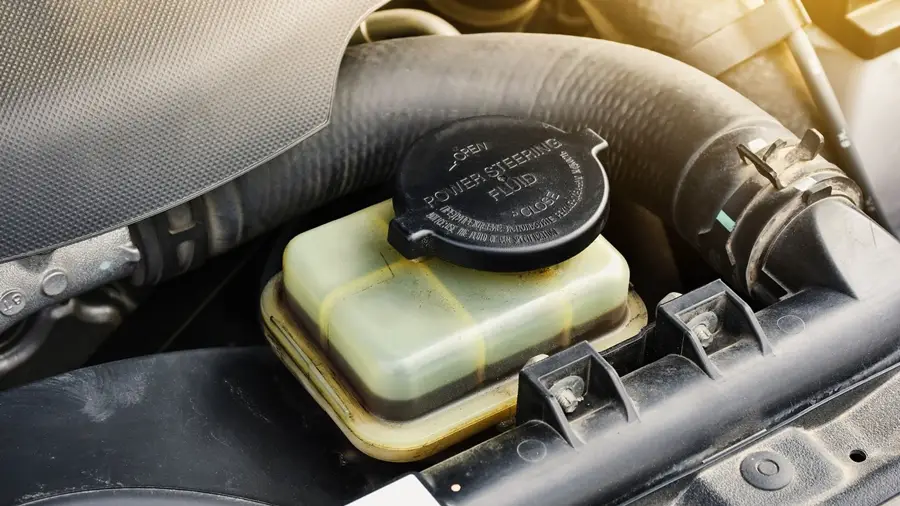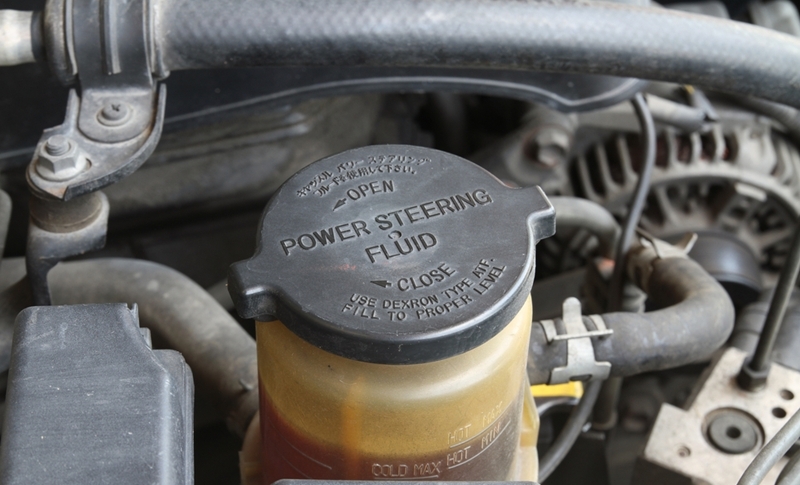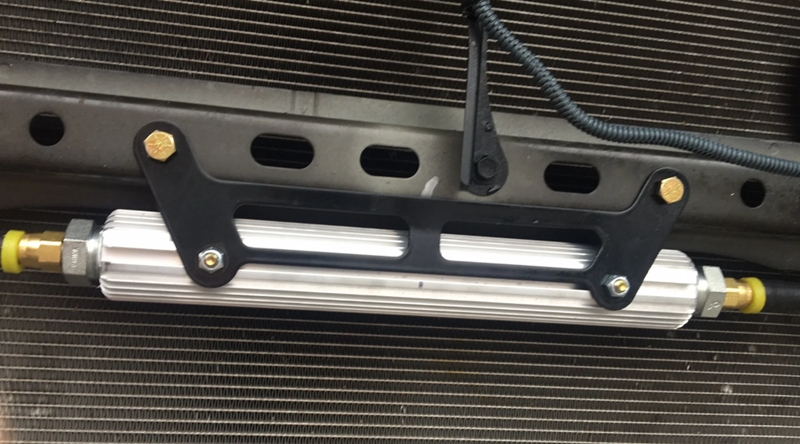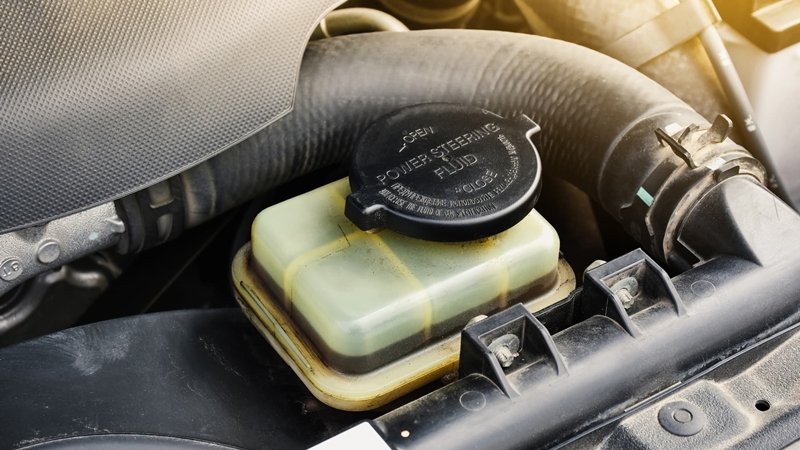Your car’s power steering system makes turning the wheel effortless, especially during parking and low-speed maneuvers. However, like all automotive systems, it requires regular maintenance to function properly. One of the most important maintenance tasks is performing a power steering oil change, also known as power steering fluid replacement.
Many drivers overlook this crucial maintenance task, leading to expensive repairs and steering problems down the road. This comprehensive guide will walk you through everything you need to know about power steering fluid maintenance, from understanding when to change it to performing the service yourself.
Table of Contents
Understanding Your Power Steering System
Before diving into the specifics of a power steering oil change, it’s essential to understand how your power steering system works. The system uses hydraulic pressure to assist your steering efforts, making it much easier to turn the wheel compared to manual steering systems.
The power steering pump, driven by your engine’s serpentine belt, pressurizes the power steering fluid and sends it to the steering rack or steering box. This pressurized fluid helps move the steering components, reducing the effort required from the driver. The fluid then returns to the reservoir to complete the cycle.
Power steering fluid serves multiple purposes beyond just hydraulic assistance. It lubricates the moving parts within the system, helps dissipate heat generated during operation, and protects against corrosion and wear. Over time, this fluid degrades and becomes contaminated, which is why a regular power steering oil change is necessary.

5 Signs You Need a Power Steering Oil Change
Recognizing the warning signs that indicate your power steering fluid needs changing can save you from costly repairs. Here are the most common symptoms that suggest it’s time for a power steering oil change:
- Fluid Color Changes: Fresh power steering fluid is typically clear, amber, or light red, depending on the brand. If your fluid appears dark brown, black, or has a burnt smell, it’s definitely time for a change. Dark fluid indicates oxidation and contamination that can damage your steering system components.
- Difficulty Steering: If you notice increased effort required to turn the steering wheel, especially at low speeds or when parking, your power steering fluid might be degraded or low. While this could indicate other issues, checking and potentially changing the fluid is a good first step.
- Whining or Groaning Noises: A whining sound when turning the steering wheel often indicates problems with the power steering system. Old, contaminated fluid can cause the pump to work harder, creating these characteristic noises.
- Foamy or Bubbly Fluid: If you check your power steering reservoir and notice the fluid appears foamy or has air bubbles, this could indicate contamination or that air has entered the system. A power steering oil change along with proper bleeding might be necessary.
- Steering Wheel Vibration: Unusual vibrations in the steering wheel, especially when turning, can sometimes be traced back to degraded power steering fluid that’s no longer providing smooth hydraulic operation.
Also read: Power Steering Oil Leak: 7 Costly Mistakes Drivers Make (And How to Avoid Them)
How Often Should You Perform a Power Steering Oil Change?
The frequency of power steering oil change depends on several factors, including your vehicle’s make and model, driving conditions, and the type of fluid used. Most automotive experts recommend changing power steering fluid every 50,000 to 100,000 miles, though some manufacturers suggest different intervals.
Manufacturer Recommendations: Check your owner’s manual for specific guidance on power steering fluid replacement intervals. Some manufacturers classify power steering fluid as a lifetime fill, but this doesn’t mean it never needs changing – it typically means changing it isn’t part of the regular maintenance schedule, but should be done if problems arise.
Driving Conditions: If you frequently drive in severe conditions such as extreme temperatures, dusty environments, or stop-and-go traffic, you may need to perform a power steering oil change more frequently. These conditions can accelerate fluid degradation.
Fluid Type Considerations: Different types of power steering fluid have varying lifespans. Synthetic fluids typically last longer than conventional fluids, but they also cost more. Some vehicles use automatic transmission fluid (ATF) as power steering fluid, which may have different change intervals.
Age of Vehicle: Older vehicles with higher mileage may benefit from more frequent power steering fluid changes, as aging seals and components can introduce more contamination into the system.

Types of Power Steering Fluid
Understanding the different types of power steering fluid available is crucial before performing a power steering oil change. Using the wrong fluid can damage your system and void warranties.
Conventional Power Steering Fluid: This is the most basic type of power steering fluid, typically petroleum-based. It’s less expensive but may not last as long as synthetic alternatives. Conventional fluid works well for most standard applications but may break down faster under extreme conditions.
Synthetic Power Steering Fluid: Synthetic fluids offer superior performance and longevity compared to conventional options. They resist breakdown better, maintain consistent viscosity across temperature ranges, and often provide better protection against wear and corrosion. While more expensive initially, synthetic fluids can extend the interval between power steering oil changes.
ATF (Automatic Transmission Fluid): Some vehicles use ATF instead of dedicated power steering fluid. This is particularly common in older vehicles and some import brands. Always check your owner’s manual to confirm whether your vehicle uses ATF or dedicated power steering fluid.
Tools and Materials Needed for Power Steering Oil Change
Before starting your power steering oil change, gather all necessary tools and materials. Having everything ready will make the process smoother and help prevent contamination.
Essential Tools:
- Turkey baster or fluid extraction pump
- Funnel (preferably with a long neck)
- Jack and jack stands (if access requires lifting the vehicle)
- Basic hand tools (wrenches, screwdrivers)
- Drain pan or container for old fluid
- Clean rags or paper towels
- Disposable gloves
Materials Needed:
- Correct type and amount of power steering fluid (typically 1-2 quarts)
- New power steering filter (if equipped)
- Clean containers for measuring fluid
Safety Equipment:
- Safety glasses
- Work gloves
- Appropriate clothing that won’t get caught in moving parts
Having quality tools makes the power steering oil change process much easier and helps ensure a professional result. Don’t skimp on safety equipment – power steering fluid can be harmful to skin and eyes.
Step-by-Step Power Steering Oil Change Procedure
Performing a power steering oil change requires careful attention to detail and proper procedure. Here’s a comprehensive step-by-step guide:
Preparation Phase: Start with a cold engine to avoid burns from hot fluid. Park on level ground and engage the parking brake. Locate the power steering fluid reservoir, typically a translucent plastic container near the engine with a cap marked with a steering wheel symbol.
Fluid Removal: Remove the reservoir cap and use a turkey baster or extraction pump to remove as much old fluid as possible. You may not be able to remove all fluid from the reservoir, but get as much as you can. Dispose of the old fluid properly at an auto parts store or recycling center.
System Flushing (Complete Method): For a thorough power steering oil change, you’ll need to flush the entire system. This involves disconnecting the return line from the power steering pump and routing it into a drain container. Have an assistant start the engine briefly while you catch the old fluid. This method removes fluid from the entire system, not just the reservoir.
Refilling the System: Add the new power steering fluid slowly through the reservoir, checking the level frequently. Don’t overfill – the fluid will expand as it warms up. Most systems hold between 1-2 quarts of fluid total.
Bleeding the System: After refilling, you must remove air from the system. Start the engine and turn the steering wheel slowly from lock to lock several times. Check the fluid level frequently and add more as needed. The fluid level will drop as air is purged from the system.
Final Checks: Once the system is properly bled and the fluid level is correct, take a short test drive. Pay attention to steering feel and listen for any unusual noises. Check the fluid level again after the test drive and top off if necessary.
Power Steering Oil Change Cost Considerations
Regular power steering oil changes are incredibly cost-effective compared to major repairs. A simple fluid change can prevent thousands in potential damage to your steering system.
Chart: Power Steering Oil Change Cost Breakdown
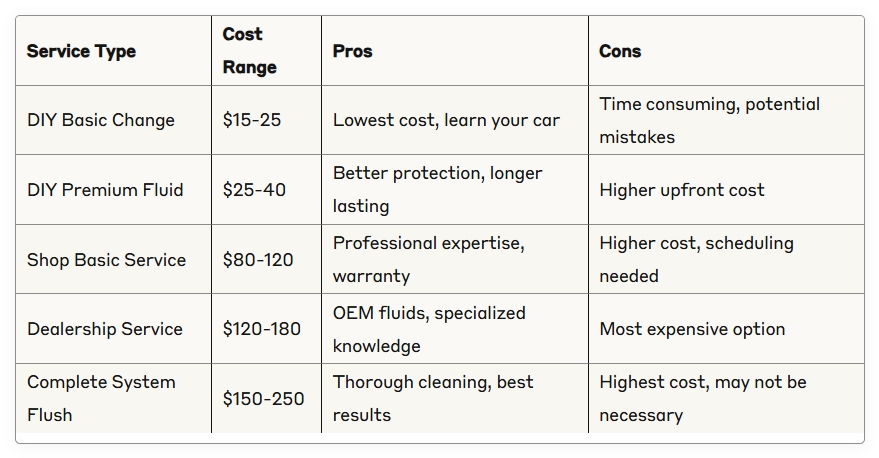
Prevention vs. Repair Costs:
- Regular fluid change: $15-40
- Power steering pump replacement: $300-800
- Steering rack replacement: $1000-2000
The math is simple – spending $30 every few years beats spending $1000+ on major repairs.
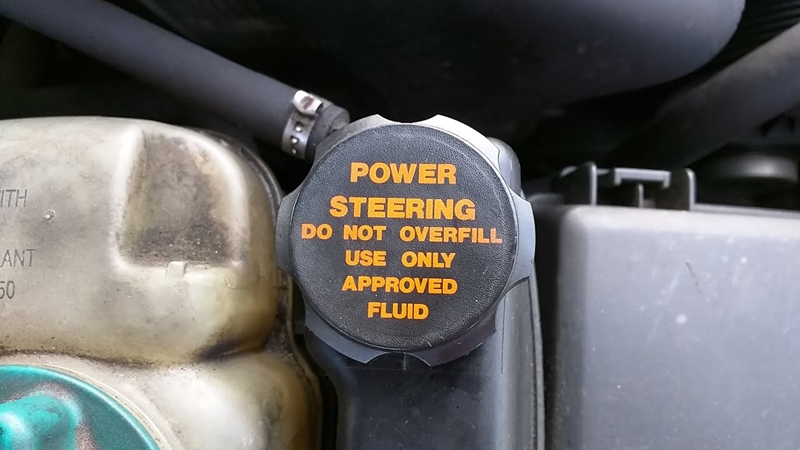
5 Critical Power Steering Oil Change Mistakes That Could Damage Your Car:
1. Using the Wrong Fluid Type
This is the most devastating mistake. Each vehicle requires a specific type of power steering fluid – some use ATF (Dexron), others need manufacturer-specific formulas (like Honda PSF), and some require universal power steering fluid. Using the wrong type can cause seal swelling, leaks, pump damage, and complete system failure. Always check your owner’s manual or reservoir cap for the exact specification.
2. Overfilling the Reservoir
Adding too much fluid creates excessive pressure and causes foaming, which reduces the fluid’s lubricating properties. Overfilled systems can blow out seals, create leaks, and cause erratic steering performance. The fluid also expands when hot, so what looks like the right level when cold can become overfilled during operation.
3. Failing to Properly Bleed Air from the System
Air trapped in the power steering system after a fluid change causes whining noises, poor steering response, and premature pump wear. Many DIYers rush this step, but proper bleeding requires slowly turning the steering wheel lock-to-lock multiple times while the engine runs, checking fluid levels frequently, and ensuring all air bubbles are purged.
4. Mixing Different Fluid Types or Brands
Combining different power steering fluids can create chemical reactions that break down additives, cause seal deterioration, and form deposits that clog the system. Even mixing different brands of the same fluid type can cause compatibility issues. Always drain the old fluid completely before adding new fluid.
5. Ignoring System Leaks Before Adding New Fluid
Adding fresh fluid to a leaking system is like pouring money down the drain. Leaks indicate worn seals, damaged lines, or component failure that will only get worse. The new fluid will quickly become contaminated or leak out, and the underlying problem will cause more damage. Always identify and fix leaks before performing a power steering oil change.
These mistakes can turn a simple $20-40 maintenance job into hundreds or thousands of dollars in repairs, including power steering pump replacement ($300-800) or steering rack replacement ($1000+).
Maintenance Tips for Extended Power Steering Life
Proper maintenance extends the life of your power steering system and reduces the frequency of power steering oil changes needed.
- Gentle Driving Habits: Avoid turning the steering wheel to full lock and holding it there, as this puts maximum stress on the system. When parking, don’t hold the wheel at full turn for extended periods.
- Belt Maintenance: Keep your serpentine belt in good condition, as it drives the power steering pump. A slipping or damaged belt can cause pump damage and fluid overheating.
- Quality Fluid: Use high-quality power steering fluid that meets or exceeds your manufacturer’s specifications. While it costs more initially, quality fluid lasts longer and provides better protection.
Troubleshooting Power Steering Problems
Even with regular power steering oil changes, problems can still occur. Understanding common issues helps you determine when professional help is needed.
Persistent Noise After Fluid Change: If your power steering system still makes noise after a power steering oil change, you may have air in the system, a failing pump, or internal component wear. Additional bleeding may help, but persistent noise often indicates mechanical problems.
Steering Still Difficult: If steering remains difficult after fresh fluid, check for proper fluid level and type. Low fluid levels or wrong fluid types can cause this problem. Mechanical issues with the pump or steering rack may also be responsible.
Foaming Fluid: If new fluid becomes foamy quickly after a power steering oil change, you may have air entering the system through a leak, or the fluid level may be too high. Check all connections and reduce fluid level if overfilled.
Rapid Fluid Darkening: If fresh fluid turns dark quickly after a power steering oil change, internal component wear may be contaminating the new fluid. This often indicates the need for professional diagnosis and possible component replacement.
Modern vehicles often have electronic power steering (EPS) systems that don’t use hydraulic fluid at all. These systems use electric motors to provide steering assistance and don’t require power steering oil changes. However, they have their own maintenance requirements and potential problems.
Chart: Power Steering Fluid Change Intervals by Vehicle Type

Chart: Power Steering Fluid Types and Compatibility
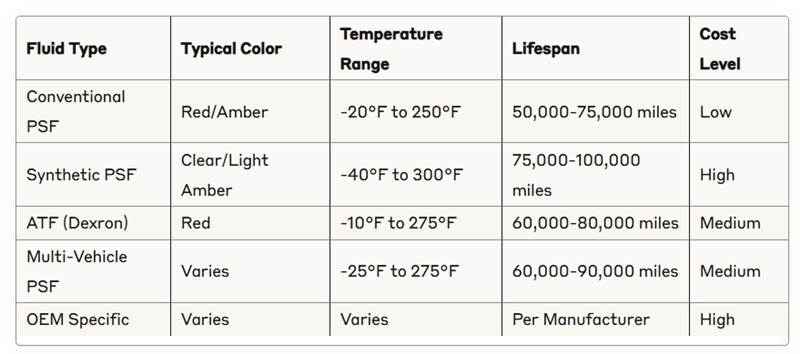
FAQ: Power Steering Oil Change
-
How do I know what type of power steering fluid my car needs?
Check your owner’s manual for the specific fluid type recommended by the manufacturer. You can also look for markings on the power steering reservoir cap, which often indicate the correct fluid type. When in doubt, consult with a qualified mechanic or parts store professional. Using the wrong fluid can damage your power steering system and void warranties.
-
Can I mix different brands of power steering fluid?
While mixing different brands of the same type of power steering fluid is generally acceptable, it’s not recommended as the best practice. Different brands may have slightly different additive packages that could interact unpredictably. For optimal performance and protection, it’s better to completely drain the old fluid and refill with a single brand and type during your power steering oil change.
-
How long does a power steering oil change take?
A basic power steering fluid replacement typically takes 30-60 minutes for a DIY job, depending on your experience level and vehicle accessibility. A complete system flush can take 1-2 hours. Professional service is usually faster, taking 30-45 minutes for most vehicles. The time can vary significantly based on the complexity of your vehicle’s power steering system.
-
What happens if I don’t change my power steering fluid?
Neglecting power steering oil change can lead to several problems including pump failure, steering rack damage, seal deterioration, and complete system failure. Old, contaminated fluid doesn’t lubricate properly and can cause excessive wear on moving parts. The cost of major repairs far exceeds the cost of regular fluid maintenance.
-
Can I use automatic transmission fluid in my power steering system?
Some vehicles are designed to use ATF as power steering fluid, but this varies by manufacturer and model. Never assume ATF is acceptable without checking your owner’s manual or consulting with a professional. Using the wrong fluid type can cause seal damage, leaks, and system failure. Always verify the correct fluid specification before performing a power steering oil change.
-
Why is my power steering fluid foamy after changing it?
Foamy power steering fluid after a power steering oil change usually indicates air in the system or overfilling. The system needs proper bleeding to remove air bubbles. It could also indicate a leak in the suction side of the system that’s drawing in air. Check fluid levels and ensure proper bleeding procedure was followed.
-
How much does power steering fluid cost?
Power steering fluid costs vary widely based on type and brand. Conventional fluid typically costs $5-15 per quart, while synthetic fluid can cost $15-30 per quart. Most vehicles require 1-2 quarts for a complete power steering oil change. OEM-specific fluids are often the most expensive but may be required for warranty compliance.
-
Can I drive with low power steering fluid?
You can drive with low power steering fluid, but it’s not recommended. Low fluid levels can cause pump damage, increased steering effort, and system failure. If you notice low fluid, add the appropriate type immediately and investigate for leaks. Continuing to drive with severely low fluid can cause expensive damage that far exceeds the cost of proper maintenance.
-
Do electric power steering systems need fluid changes?
No, electric power steering (EPS) systems don’t use hydraulic fluid and therefore don’t require power steering oil changes. These systems use electric motors for assistance and have different maintenance requirements. If you’re unsure whether your vehicle has hydraulic or electric power steering, check your owner’s manual or consult with a professional.
-
What’s the difference between power steering fluid and brake fluid?
Power steering fluid and brake fluid are completely different and should never be substituted for each other. Brake fluid is typically glycol-based and has different properties required for brake system operation. Power steering fluid is usually petroleum-based (except in some systems that use ATF). Using brake fluid in a power steering system or vice versa can cause severe damage and safety issues.
Need a mechanic? Find one on the Mobile Mechanic Directory
Final Thoughts
Regular power steering oil change is essential maintenance that keeps your steering system operating smoothly and prevents costly repairs. Remember to always use the correct fluid type, follow proper procedures, and dispose of old fluid responsibly. When in doubt, consult with qualified professionals who can provide guidance specific to your vehicle’s needs.

